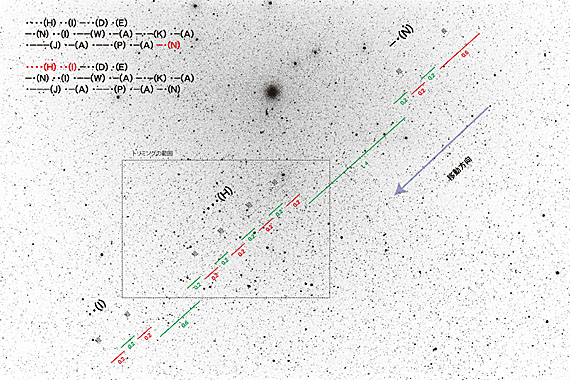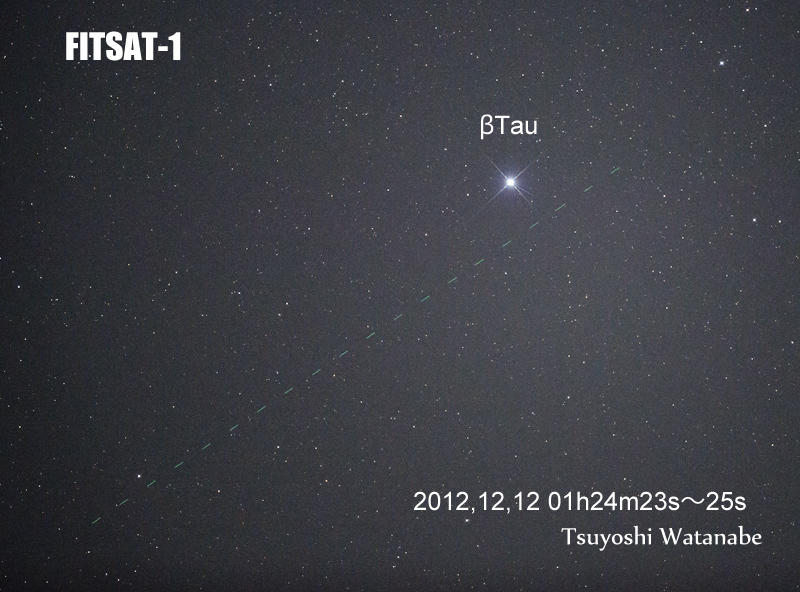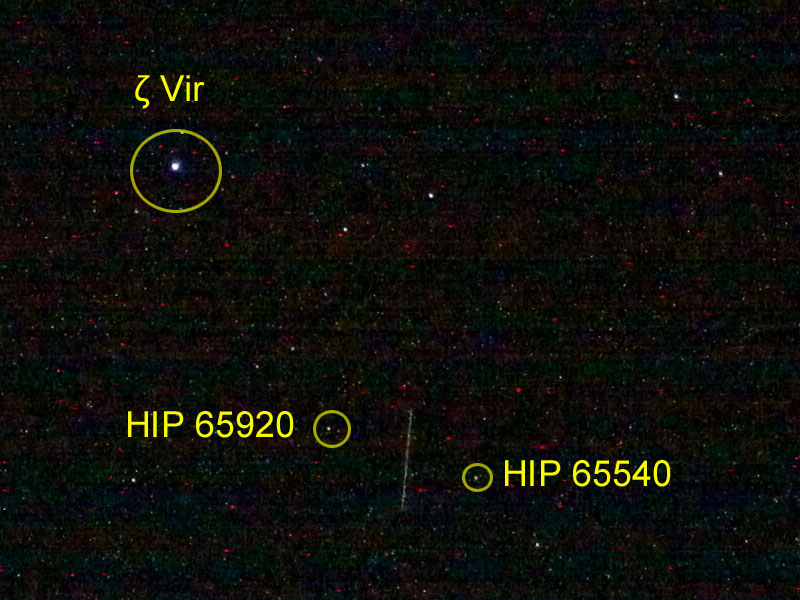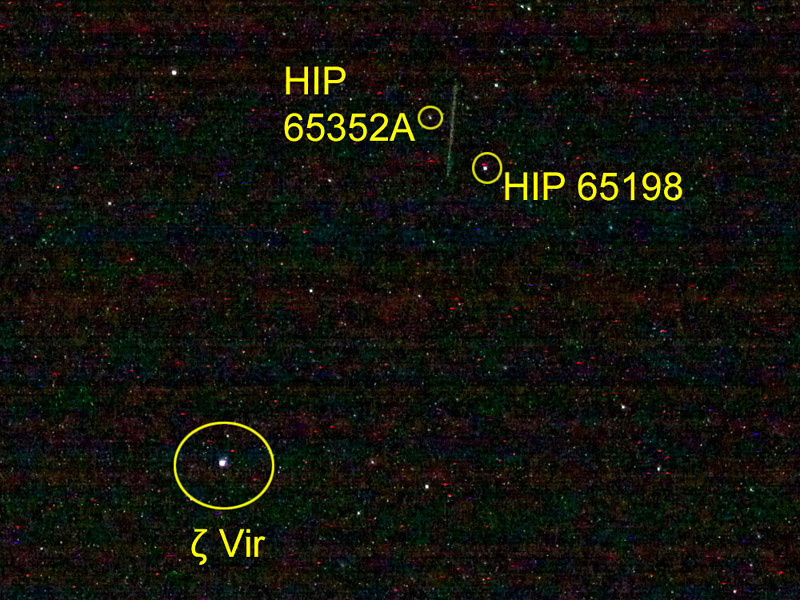FITSAT-1 LED Flashing Experiments Successful

[HP]
http://www.fit.ac.jp/~tanaka/fitsat.shtml
[Guide]
http://www.jinkou-eisei.jp/FITSAT/index.html
http://www.jinkou-eisei.jp/FITSAT/obs.html
http://www.jinkou-eisei.jp/FITSAT/obs02_1.html
http://www.jinkou-eisei.jp/FITSAT/obs02_2.html
http://www.jinkou-eisei.jp/FITSAT/obs02_3.html
https://sites.google.com/site/myniwakapage/
 02:14-02:14JST, 11 Dec 2012, Ele 29 deg in Yokohama Japan
02:14-02:14JST, 11 Dec 2012, Ele 29 deg in Yokohama Japan



 04:19-04:26JST, 16 Jan 2013, Ele 33 deg in Yokohama Japan
[LED Schedule]
04:19-04:26JST, 16 Jan 2013, Ele 33 deg in Yokohama Japan
[LED Schedule]
 http://www.fit.ac.jp/~tanaka/fitsat.shtml
http://www.satflare.com/track.php?q=fitsat#MAP
[LED Observation] #1
http://www.jinkou-eisei.jp/FITSAT/121211_news.html
http://www.jinkou-eisei.jp/FITSAT/images/121211_m.jpg
http://www.fit.ac.jp/~tanaka/fitsat.shtml
http://www.satflare.com/track.php?q=fitsat#MAP
[LED Observation] #1
http://www.jinkou-eisei.jp/FITSAT/121211_news.html
http://www.jinkou-eisei.jp/FITSAT/images/121211_m.jpg
 (C)Kurashiki Science Center
Kurashiki City, Okayama Japan
2:17:30-2:19:30JST, 11 Dec 2012
Diameter short focus telescope 10cm (F=400mm F4)
Nikon D800, ISO12800, 10 seconds exposure
[LED Observation] #2
http://www.jinkou-eisei.jp/FITSAT/121212_news.html
http://www.jinkou-eisei.jp/FITSAT/images/121212_watanabe.jpg
(C)Kurashiki Science Center
Kurashiki City, Okayama Japan
2:17:30-2:19:30JST, 11 Dec 2012
Diameter short focus telescope 10cm (F=400mm F4)
Nikon D800, ISO12800, 10 seconds exposure
[LED Observation] #2
http://www.jinkou-eisei.jp/FITSAT/121212_news.html
http://www.jinkou-eisei.jp/FITSAT/images/121212_watanabe.jpg
 (C)Tsuyoshi Watanabe
Ebina City, Kanagawa Japan
1:24:23-1:24:25JST, 12 Dec 2012
Takahashi e160, Diameter short focus telescope 16cm (F=530mm, F3.3)
Nikon D800E, ISO12800, 2 seconds exposure
[LED Video]
It was succeeded in the video of the FITSAT-1 LED (10Hz) on 14 Dec 2012
by Toyama Astronomical Observatory in Japan. Because they pursued FITSAT-1,
it seems to us so that the many stars flow through the back of a satellite
flashing on and off small in the vicinity of the screen center.
Note: In the video, they are many ordinary stars not the meteors.
FITSAT-1 Video
http://www.tsm.toyama.toyama.jp/_ex/curators/hayashi/20121214FITSAT.avi (490MB)
http://www.tsm.toyama.toyama.jp/_ex/curators/hayashi/20121214FITSAT.mpg (144MB)
http://www.jinkou-eisei.jp/FITSAT/images/121214_toyama_FITSAT.wmv ( 72MB)
http://www.jinkou-eisei.jp/FITSAT/121214_news.html
FITSAT-1 Screen Shot
(C)Tsuyoshi Watanabe
Ebina City, Kanagawa Japan
1:24:23-1:24:25JST, 12 Dec 2012
Takahashi e160, Diameter short focus telescope 16cm (F=530mm, F3.3)
Nikon D800E, ISO12800, 2 seconds exposure
[LED Video]
It was succeeded in the video of the FITSAT-1 LED (10Hz) on 14 Dec 2012
by Toyama Astronomical Observatory in Japan. Because they pursued FITSAT-1,
it seems to us so that the many stars flow through the back of a satellite
flashing on and off small in the vicinity of the screen center.
Note: In the video, they are many ordinary stars not the meteors.
FITSAT-1 Video
http://www.tsm.toyama.toyama.jp/_ex/curators/hayashi/20121214FITSAT.avi (490MB)
http://www.tsm.toyama.toyama.jp/_ex/curators/hayashi/20121214FITSAT.mpg (144MB)
http://www.jinkou-eisei.jp/FITSAT/images/121214_toyama_FITSAT.wmv ( 72MB)
http://www.jinkou-eisei.jp/FITSAT/121214_news.html
FITSAT-1 Screen Shot
 (C)Tadashi Hayashi
Toyama City, Toyama Japan
1:09:04-1:11:04JST, 14 Dec 2012
CONTRAVES telescope 100cm (F=8000mm) changed to F=800mm
by Eye piece(F=60mm) and C_Mount camera lens(F=6mm, F0.8)
WATEC Neptune100 (Monochromatic video camera)
Toyama Astronomical Observatory
http://www.tsm.toyama.toyama.jp/tao/index.htm
The International Project for Radio Meteor Observation
http://www.amro-net.jp/radio.htm
[LED Schedule Update]
(C)Tadashi Hayashi
Toyama City, Toyama Japan
1:09:04-1:11:04JST, 14 Dec 2012
CONTRAVES telescope 100cm (F=8000mm) changed to F=800mm
by Eye piece(F=60mm) and C_Mount camera lens(F=6mm, F0.8)
WATEC Neptune100 (Monochromatic video camera)
Toyama Astronomical Observatory
http://www.tsm.toyama.toyama.jp/tao/index.htm
The International Project for Radio Meteor Observation
http://www.amro-net.jp/radio.htm
[LED Schedule Update]
 http://www.fit.ac.jp/~tanaka/fitsat.shtml
http://www.satflare.com/track.php?q=fitsat#MAP
http://turing.cs.fit.ac.jp/~fitsat/led_world.html
http://turing.cs.fit.ac.jp/~fitsat/led.html
23:01-23:11JST, 17 Dec 2012, Ele 62 NW-W-S-SE
The flashing planned time over Japan, it's 2 minutes of 23:05:30-23:07:30JST.
The viewpoint in Yokohama is from right under Jupiter to the neighborhood of
the central three stars of Orion. I examined it to here, but the observation
seems to be impossible because the weather of Yokohama will be rain tomorrow.
http://www.fit.ac.jp/~tanaka/fitsat.shtml
http://www.satflare.com/track.php?q=fitsat#MAP
http://turing.cs.fit.ac.jp/~fitsat/led_world.html
http://turing.cs.fit.ac.jp/~fitsat/led.html
23:01-23:11JST, 17 Dec 2012, Ele 62 NW-W-S-SE
The flashing planned time over Japan, it's 2 minutes of 23:05:30-23:07:30JST.
The viewpoint in Yokohama is from right under Jupiter to the neighborhood of
the central three stars of Orion. I examined it to here, but the observation
seems to be impossible because the weather of Yokohama will be rain tomorrow.

 [LED New Photos]
20130111: New flashing plan:
10th Jan. 23:57:30 - 23:59:30 UTC New Delhi India (10Hz Green)
11th Jan. 13:52:30 - 13:54:30 UTC San Francisco USA (10Hz Green)
12th Jan. 15:38:00 - 15:40:00 UTC SE Australia (10Hz Red)
14th Jan. 11:02:30 - 11:04:30 UTC Central USA (10Hz Green)
15th Jan. 22:26:00 - 22:28:00 UTC Wulmuqi China (10Hz Green)
17th Jan. 20:22:30 - 20:24:30 UTC Central India (10Hz Green)
19th Jan. 03:19:00 - 03:21:00 UTC North Italy (10Hz Green)
20130113: Miss Jodie Reynolds K6JLR and Mr. Will Bierman took photos of
flashing NIWAKA successfully using standard lens (f=40mm, 2.5sec exposure):
2013.01.11, 13:53:07 UTC 2013.01.11, 13:53:24 UTC
[LED New Photos]
20130111: New flashing plan:
10th Jan. 23:57:30 - 23:59:30 UTC New Delhi India (10Hz Green)
11th Jan. 13:52:30 - 13:54:30 UTC San Francisco USA (10Hz Green)
12th Jan. 15:38:00 - 15:40:00 UTC SE Australia (10Hz Red)
14th Jan. 11:02:30 - 11:04:30 UTC Central USA (10Hz Green)
15th Jan. 22:26:00 - 22:28:00 UTC Wulmuqi China (10Hz Green)
17th Jan. 20:22:30 - 20:24:30 UTC Central India (10Hz Green)
19th Jan. 03:19:00 - 03:21:00 UTC North Italy (10Hz Green)
20130113: Miss Jodie Reynolds K6JLR and Mr. Will Bierman took photos of
flashing NIWAKA successfully using standard lens (f=40mm, 2.5sec exposure):
2013.01.11, 13:53:07 UTC 2013.01.11, 13:53:24 UTC

 data
but not confirmed. At it was just before dawn,
other satellites were also bright by sunlit.
http://www.fit.ac.jp/~tanaka/fitsat.shtml (English)
http://turing.cs.fit.ac.jp/~fitsat/led_japan.php (Japan)
[LED Observation] #3
data
but not confirmed. At it was just before dawn,
other satellites were also bright by sunlit.
http://www.fit.ac.jp/~tanaka/fitsat.shtml (English)
http://turing.cs.fit.ac.jp/~fitsat/led_japan.php (Japan)
[LED Observation] #3

 ISO12800 ISO1600
(C)JR5EPQ / Shozo Sasaoka
Seiyo City, Ehime Japan
4:21:10JST, 16 Jan 2013
Canon EOS 60Da + PPENTAX SMC-P
2 seconds exposure
Left, ISO12800 f=500mm F4.5
Right,ISO1600 B/W reverse, f=135ćo F2.5
(Cf) by Simone
ISO12800 ISO1600
(C)JR5EPQ / Shozo Sasaoka
Seiyo City, Ehime Japan
4:21:10JST, 16 Jan 2013
Canon EOS 60Da + PPENTAX SMC-P
2 seconds exposure
Left, ISO12800 f=500mm F4.5
Right,ISO1600 B/W reverse, f=135ćo F2.5
(Cf) by Simone
 ü@http://www.satflare.com/fpas_reader.html?id=GSC73A201301151921
[FITSAT-1 Flashing Plan]
20130121:
We have learned through the experiments of flashing NIWAKA:
1. The night sky must be dark enough to see the milky way.
2. Photos successfully used around F4, 400mm lens and ISO12800 camera.
3. Most people noticed their success after took photo and magnified.
This means the camera must be turned to the accurate direction, and
shuttered at exact time. Multiple shutters will be useful.
4. The green beam always turn to the magnetic north, and the red beam
turn to the magnetic south, so the beams do not turn to the ground
around the equator. In order to observe the light, higher latitude
will be good result.
As observing the light is not so easy, we will flash the light on
request. If you have a plan for observing the light, please advice me
the time and date with your latitude and longitude. Now we have a plan
for flashing at 09:25:00 on 9th Feb. for the west coast of USA.
(Time will be changed by the latest TLE.)
http://www.fit.ac.jp/~tanaka/fitsat.shtml
[LED Observation] #4
ü@http://www.satflare.com/fpas_reader.html?id=GSC73A201301151921
[FITSAT-1 Flashing Plan]
20130121:
We have learned through the experiments of flashing NIWAKA:
1. The night sky must be dark enough to see the milky way.
2. Photos successfully used around F4, 400mm lens and ISO12800 camera.
3. Most people noticed their success after took photo and magnified.
This means the camera must be turned to the accurate direction, and
shuttered at exact time. Multiple shutters will be useful.
4. The green beam always turn to the magnetic north, and the red beam
turn to the magnetic south, so the beams do not turn to the ground
around the equator. In order to observe the light, higher latitude
will be good result.
As observing the light is not so easy, we will flash the light on
request. If you have a plan for observing the light, please advice me
the time and date with your latitude and longitude. Now we have a plan
for flashing at 09:25:00 on 9th Feb. for the west coast of USA.
(Time will be changed by the latest TLE.)
http://www.fit.ac.jp/~tanaka/fitsat.shtml
[LED Observation] #4
 (C)Mr. mossch
Seiwa Forest Kimitsu, Chiba Japan
23:51:00-23:53:00JST, 13 Feb 2013
Nikon D90, AF NIKKOR 180mm F2.8, ISO Hi1
6 seconds exposure, Equivalent to ISO6400
sensitizing one step of the ISO3200
http://www.flickr.com/photos/54092930@N02/8470529641/
http://www.astroarts.jp/photo-gallery/
(C)AstroArts
(C)Mr. mossch
Seiwa Forest Kimitsu, Chiba Japan
23:51:00-23:53:00JST, 13 Feb 2013
Nikon D90, AF NIKKOR 180mm F2.8, ISO Hi1
6 seconds exposure, Equivalent to ISO6400
sensitizing one step of the ISO3200
http://www.flickr.com/photos/54092930@N02/8470529641/
http://www.astroarts.jp/photo-gallery/
(C)AstroArts
 Back to Top
Back to Top
 Back to Home Page
Back to Home Page


02:14-02:14JST, 11 Dec 2012, Ele 29 deg in Yokohama Japan



04:19-04:26JST, 16 Jan 2013, Ele 33 deg in Yokohama Japan [LED Schedule]
http://www.fit.ac.jp/~tanaka/fitsat.shtml http://www.satflare.com/track.php?q=fitsat#MAP [LED Observation] #1 http://www.jinkou-eisei.jp/FITSAT/121211_news.html http://www.jinkou-eisei.jp/FITSAT/images/121211_m.jpg
(C)Kurashiki Science Center Kurashiki City, Okayama Japan 2:17:30-2:19:30JST, 11 Dec 2012 Diameter short focus telescope 10cm (F=400mm F4) Nikon D800, ISO12800, 10 seconds exposure [LED Observation] #2 http://www.jinkou-eisei.jp/FITSAT/121212_news.html http://www.jinkou-eisei.jp/FITSAT/images/121212_watanabe.jpg
(C)Tsuyoshi Watanabe Ebina City, Kanagawa Japan 1:24:23-1:24:25JST, 12 Dec 2012 Takahashi e160, Diameter short focus telescope 16cm (F=530mm, F3.3) Nikon D800E, ISO12800, 2 seconds exposure [LED Video] It was succeeded in the video of the FITSAT-1 LED (10Hz) on 14 Dec 2012 by Toyama Astronomical Observatory in Japan. Because they pursued FITSAT-1, it seems to us so that the many stars flow through the back of a satellite flashing on and off small in the vicinity of the screen center. Note: In the video, they are many ordinary stars not the meteors. FITSAT-1 Video http://www.tsm.toyama.toyama.jp/_ex/curators/hayashi/20121214FITSAT.avi (490MB) http://www.tsm.toyama.toyama.jp/_ex/curators/hayashi/20121214FITSAT.mpg (144MB) http://www.jinkou-eisei.jp/FITSAT/images/121214_toyama_FITSAT.wmv ( 72MB) http://www.jinkou-eisei.jp/FITSAT/121214_news.html FITSAT-1 Screen Shot
(C)Tadashi Hayashi Toyama City, Toyama Japan 1:09:04-1:11:04JST, 14 Dec 2012 CONTRAVES telescope 100cm (F=8000mm) changed to F=800mm by Eye piece(F=60mm) and C_Mount camera lens(F=6mm, F0.8) WATEC Neptune100 (Monochromatic video camera) Toyama Astronomical Observatory http://www.tsm.toyama.toyama.jp/tao/index.htm The International Project for Radio Meteor Observation http://www.amro-net.jp/radio.htm [LED Schedule Update]
http://www.fit.ac.jp/~tanaka/fitsat.shtml http://www.satflare.com/track.php?q=fitsat#MAP http://turing.cs.fit.ac.jp/~fitsat/led_world.html http://turing.cs.fit.ac.jp/~fitsat/led.html 23:01-23:11JST, 17 Dec 2012, Ele 62 NW-W-S-SE The flashing planned time over Japan, it's 2 minutes of 23:05:30-23:07:30JST. The viewpoint in Yokohama is from right under Jupiter to the neighborhood of the central three stars of Orion. I examined it to here, but the observation seems to be impossible because the weather of Yokohama will be rain tomorrow.

[LED New Photos] 20130111: New flashing plan: 10th Jan. 23:57:30 - 23:59:30 UTC New Delhi India (10Hz Green) 11th Jan. 13:52:30 - 13:54:30 UTC San Francisco USA (10Hz Green) 12th Jan. 15:38:00 - 15:40:00 UTC SE Australia (10Hz Red) 14th Jan. 11:02:30 - 11:04:30 UTC Central USA (10Hz Green) 15th Jan. 22:26:00 - 22:28:00 UTC Wulmuqi China (10Hz Green) 17th Jan. 20:22:30 - 20:24:30 UTC Central India (10Hz Green) 19th Jan. 03:19:00 - 03:21:00 UTC North Italy (10Hz Green) 20130113: Miss Jodie Reynolds K6JLR and Mr. Will Bierman took photos of flashing NIWAKA successfully using standard lens (f=40mm, 2.5sec exposure): 2013.01.11, 13:53:07 UTC 2013.01.11, 13:53:24 UTC

data but not confirmed. At it was just before dawn, other satellites were also bright by sunlit. http://www.fit.ac.jp/~tanaka/fitsat.shtml (English) http://turing.cs.fit.ac.jp/~fitsat/led_japan.php (Japan) [LED Observation] #3

ISO12800 ISO1600 (C)JR5EPQ / Shozo Sasaoka Seiyo City, Ehime Japan 4:21:10JST, 16 Jan 2013 Canon EOS 60Da + PPENTAX SMC-P 2 seconds exposure Left, ISO12800 f=500mm F4.5 Right,ISO1600 B/W reverse, f=135ćo F2.5 (Cf) by Simone
ü@http://www.satflare.com/fpas_reader.html?id=GSC73A201301151921 [FITSAT-1 Flashing Plan] 20130121: We have learned through the experiments of flashing NIWAKA: 1. The night sky must be dark enough to see the milky way. 2. Photos successfully used around F4, 400mm lens and ISO12800 camera. 3. Most people noticed their success after took photo and magnified. This means the camera must be turned to the accurate direction, and shuttered at exact time. Multiple shutters will be useful. 4. The green beam always turn to the magnetic north, and the red beam turn to the magnetic south, so the beams do not turn to the ground around the equator. In order to observe the light, higher latitude will be good result. As observing the light is not so easy, we will flash the light on request. If you have a plan for observing the light, please advice me the time and date with your latitude and longitude. Now we have a plan for flashing at 09:25:00 on 9th Feb. for the west coast of USA. (Time will be changed by the latest TLE.) http://www.fit.ac.jp/~tanaka/fitsat.shtml [LED Observation] #4
(C)Mr. mossch Seiwa Forest Kimitsu, Chiba Japan 23:51:00-23:53:00JST, 13 Feb 2013 Nikon D90, AF NIKKOR 180mm F2.8, ISO Hi1 6 seconds exposure, Equivalent to ISO6400 sensitizing one step of the ISO3200 http://www.flickr.com/photos/54092930@N02/8470529641/ http://www.astroarts.jp/photo-gallery/ (C)AstroArts